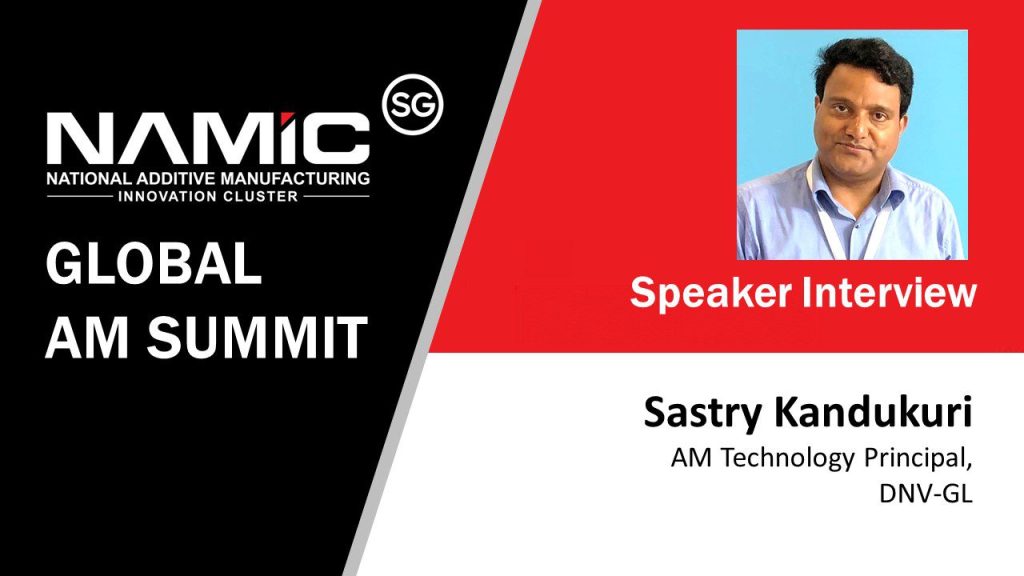1. Please share your story on the journey towards Technology Adoption.
DNV GL has been investigating the potential of 3D printing / additive manufacturing (AM) for the maritime and oil & gas sectors for a bit less than a decade. In November, last year, DNV GL published the first guideline for the use of AM in the maritime and oil & gas industries, creating a clear pathway and systematic processes to assess every parameter that will impact upon the final products – from the raw material. Earlier this year, we set-up our Global Additive Manufacturing (AM) Technology Centre of Excellence in Singapore in order to promote the application of additive manufacturing to enhance the manufacturing competitiveness of global marine and offshore engineering industries. The center in Singapore is part of a global network in DNV GL that has AM competence, particularly in Norway, Germany, UK and USA. These offices then branch out to the regional networks of industry players, universities, research facilities and start up communities. This allows DNV GL to be a hub for knowledge sharing and best practices on AM worldwide.

2. How do you think 3D printing has improved and impacted the quality of people’s life?
3D printing has changed the way they do things in ways they never thought of doing before. It is truly revolutionizing the way products are manufactured, distributed and delivered. Everything from new consumer goods to jewelry and clothing will be designed more rapidly, helping to bring designs and inventions to the end user faster than the industrial revolution did over the last few centuries. This will grow the economy at a faster pace and as a result, it will improve the quality of people’s lives significantly.
3. What do you think the future of 3D printing holds? What new developments can we expect in the next 5 years?
DNV GL is optimistic with the robust growth and widespread adoption of AM. In general, in the next 5 years we expect to see a range of 3D printed spare parts and a lot of structurally sensitive and geometrically complex parts for safety-critical applications on full scale in M & O industries.
4. What does 3D Printing mean to you and to your business success?
DNV GL view additive manufacturing together with digitalization as another potential game changer in the M&O industry. Not only could AM result in new designs for more efficient components, it reduces the lead time, cost, logistics, and the need to keep stocks of spare parts. This would greatly shorten the time required for maintenance and repairs and contribute to more efficient operations.
5. What new business opportunities, can we look forward to in Industry 4.0, especially in your industry?
DNV GL believes that adoption of additive manufacturing will play a key role in realizing the potential benefits of digitalization in M & O industries. When matured, 3D printing technology is expected to provide an archive of digital catalogues of parts for immediate on-site printing rather than maintaining physical inventories of spare parts and/or waiting for them to be made and transported to a platform or vessel.
6. From your experience, what are the limitations/roadblocks for companies using Additive Manufacturing and what advise will you give to startups wanting jump on the bandwagon?
Some of the challenges for adoption of Additive manufacturing including but not limited to
- Lack of awareness or trust about the potential benefits of adopting AM
- Difficulty to know where to start due to overwhelming and conflicting information about different processes and their capabilities.
- Lack of structured and matured AM supply-chain
- Lack of regulatory standards
- Lack of knowledge about qualification and certification requirements
- Unclear IP, legal and regulatory issues
- Concerns about data protection, counterfeiting & product sabotage issues
Addressing these challenges for adoption of Additive manufacturing will depend on new ways of working. Companies should also consider collaborating with the industry to tackle common issues and share best practices.

7. Is 3D Printing the game changer for the Industrial revolution 4.0 and is it here to stay for the long haul?
DNV GL believes 3D Printing is the game changer for the Industrial revolution 4.0 and we are optimistic with the robust growth and widespread adoption of AM in M&O industries. We are looking forward to help the industry to reap the benefits of AM on sustainability principles.

